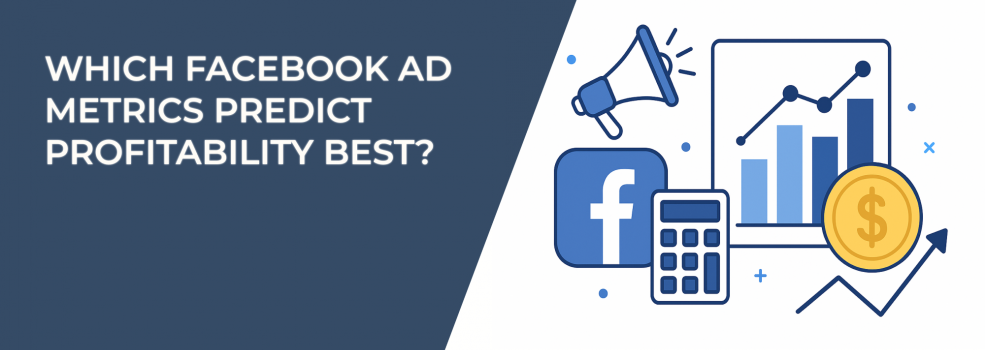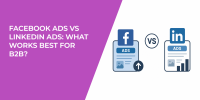When you run Facebook ads, numbers flood your dashboard. Impressions. Reach. Clicks. CTR. The list goes on. But which ones actually tell you if your campaign is profitable? Not every metric matters equally. Some are surface-level, while others reveal the real story about revenue and ROI.
Let’s dig into the Facebook ad metrics that best predict profitability — and how to read them in a way that drives smarter decisions.
1. Return on Ad Spend (ROAS)
ROAS is the most direct profitability indicator. It tells you how much revenue you generate for every dollar spent.
Formula: Revenue ÷ Ad Spend
Example: If you spend $1,000 and generate $3,500 in sales, your ROAS is 3.5. That means for every $1, you earned $3.50 back.
But the real insight comes when you track ROAS across ad sets. Some audiences or creatives will hit a ROAS of 5.0, while others sink below 1. If you only look at overall campaign numbers, you’ll miss the fact that one ad is carrying the rest.
Tip: Set a target ROAS based on your profit margins. If your margin is 40%, you’ll need at least a 2.5 ROAS to break even.
The more consistently you measure ROAS, the easier it becomes to spot winning campaigns early and shift budget toward them while cutting underperformers.
If your ROAS feels stuck, there are advanced tactics to improve Facebook ROAS without raising spend that can help you squeeze more revenue from the same budget..
2. Cost per Purchase (CPP)
Want to know if your ad dollars are efficient? Watch your cost per purchase.
This metric tells you how much you’re paying for each transaction. A lower CPP generally means better profitability, but context matters. If you’re selling a $20 product and your CPP is $18, you’re cutting it close. But if you’re selling a $300 product, an $18 CPP looks fantastic.
How to use it: Compare CPP with your average order value (AOV). The wider the gap, the healthier your profits.
It’s worth reviewing CPP regularly because it fluctuates as auctions change and competitors adjust their bids. Keeping an eye on it helps you anticipate shifts before they eat into your margins.
Rather than focusing only on surface metrics, you’ll get a clearer picture by analyzing Facebook ad performance beyond CTR and CPC.
3. Average Order Value (AOV)
AOV doesn’t live inside Ads Manager — but it’s one of the strongest predictors of profitability. Why? Because it shows how much customers spend per purchase.
If you can increase AOV, even slightly, your profitability rises without increasing ad spend. For example, bumping AOV from $50 to $65 can transform a borderline campaign into a profitable one.
Quick wins to increase AOV:
-
Offer product bundles or “frequently bought together” discounts.
-
Introduce tiered pricing with incentives for larger orders.
-
Use post-purchase upsells.
Each of these tactics pushes the customer gently toward spending more in a way that feels natural. When done right, AOV lifts without harming conversion rates, which is why it’s such a reliable lever for improving profitability.
A smart funnel design plays a big role here, and a Facebook ads funnel strategy built for conversion can help lift AOV while guiding buyers toward larger purchases.
4. Conversion Rate (CVR)
Traffic alone doesn’t bring profit. The percentage of visitors who actually buy — that’s where profit is made.
A CVR of 1% may be normal in some industries, but with better landing pages, it can climb to 3% or even 5%. That difference can mean the gap between breaking even and scaling profitably.
Ask yourself: Are your landing pages fast? Do they match the ad promise? Is checkout seamless? Every tiny friction point hurts CVR — and by extension, profitability.
When you start tracking CVR closely, you’ll see patterns that explain why campaigns underperform. Small design fixes or clearer calls to action often boost results more than simply raising your ad budget.
If your CVR is consistently low, it’s worth reviewing why Facebook ads aren’t converting and how to fix it.
5. Customer Lifetime Value (CLV)
Profitability is not only about the first sale. CLV predicts how much a customer is worth over time.
If you’re acquiring customers at a $30 cost per purchase, but their lifetime value is $300, the economics work beautifully. On the flip side, if CLV is too close to CPP, the long-term picture looks grim.
How to maximize CLV:
-
Run retargeting ads to bring buyers back.
-
Build an email or SMS flow for repeat purchases.
-
Launch loyalty programs to keep customers engaged.
Think of CLV as the north star for growth. Once you know it, you can confidently spend more upfront to acquire customers, knowing that profits come back over months rather than days.
6. Frequency and Saturation Metrics
One overlooked predictor of profitability is ad fatigue. If frequency climbs above 3–4 within a short time frame, performance usually drops. Costs rise, CTR falls, and conversions slow.
By watching frequency alongside CTR, you’ll know when to refresh creative or expand your audience. Fresh ads maintain engagement and prevent wasted spend.
This metric doesn’t directly show profit, but it warns you when profitability is about to slip. Use it as an early signal to update creatives or diversify your targeting before costs escalate.
When frequency rises too high, you risk ad fatigue — here’s how to spot it early and fix it fast.
7. Cost per Lead (CPL) — but only in context
CPL gets a lot of attention, but on its own, it doesn’t predict profitability. Leads mean nothing unless they convert into paying customers.
The trick is to pair CPL with conversion rate and AOV. For example:
-
A $10 CPL looks cheap, but if only 1% of leads buy, profitability crumbles.
-
A $40 CPL can still be profitable if those leads convert at a higher rate and purchase more valuable products.
So, CPL is not useless — it just needs to be part of a bigger picture. When combined with conversion and purchase data, it becomes a powerful way to understand if your campaigns are truly delivering profitable customers.
So, which metrics matter most?
The metrics that best predict profitability are ROAS, CPP, AOV, CVR, and CLV. Together, they form a profitability equation. The others — frequency, CTR, CPL — help explain why performance looks the way it does, but they aren’t the final verdict.
When you combine them, you get a clear picture:
-
ROAS tells you revenue efficiency.
-
CPP shows acquisition cost.
-
AOV reveals transaction value.
-
CVR highlights funnel strength.
-
CLV captures long-term potential.
Everything else is supportive, not predictive. And that distinction helps you avoid chasing vanity metrics while keeping focus on what really matters.
Final Thoughts
Profitability isn’t about chasing every shiny metric in Ads Manager. It’s about zeroing in on the handful that truly connect ad spend to revenue.
If you want to make better decisions, don’t just ask, “How many clicks did I get?” Ask instead: “How much profit did those clicks generate?”
The advertisers who master this shift — from vanity metrics to profitability metrics — are the ones who stop wasting spend and start scaling sustainably.

